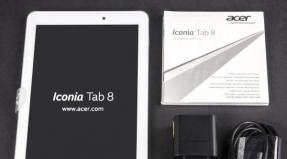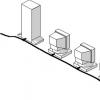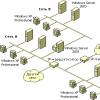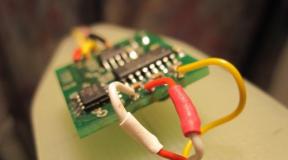Ultrapixel is a new camera technology from HTC. What is UltraPixel? The difference between shooting in low light between cameras with large pixels and regular ones
As you know, the new flagship smartphone HTC One (this time there is really one, and not three, like last year) boasts an unusual camera with UltraPixel technology and optical image stabilization. And if everything is more or less clear with stabilization, then UltraPixel raises certain questions. So let's figure out together what it is and why this technology different from “regular” cameras.
![]() Camera appearance in HTC One
Camera appearance in HTC One
To understand what's behind the UltraPixel marketing name, first let's look at how a "regular" camera with a Bayer color filter array works. The little secret of such cameras (that is, 99.9% of all cameras on the market) is that what is indicated in technical specifications the resolution is a fiction and a sleight of hand. More precisely, there are really exactly as many photosensitive elements (sensors) on the matrix as written, but the problem is that each of them sees only one color (blue, green or red). Thus, the full declared resolution is achieved only in black and white mode, and in color mode, the color of each final pixel is interpolated from the readings of several (usually four) sensors.
![]()
Structure of a matrix with a Bayer array of color filters
A side effect of the Bayer array of color filters is the need to use an anti-aliasing filter, which is installed in front of the sensor and slightly “smears” the image. This is done to avoid color artifacts and moire. At the same time, resolution suffers - this is why the picture from “regular” cameras at 100% scale without additional software sharpening always looks somewhat blurry. (There are cameras with Bayer sensors without an anti-aliasing filter, but you can count them on the fingers of one hand.)
The matrix with UltraPixel technology has a fundamentally different structure. It uses three layers of photosensitive elements. Elements in one layer are sensitive to blue, in the second to green and in the third to red. Such a three-layer sensor immediately receives full color information, due to which the color resolution of the UltraPixel matrix is equal to the brightness, and an anti-aliasing filter is simply not needed.
![]()
Sensel on a “three-layer” matrix in section
This idea is actually not new - Foveon has been producing Foveon X3 matrices for many years, which, in turn, are used in Sigma cameras. At the time of their appearance on the market, Foveon matrices had the highest metameric index (that is, the most correct color rendition) among all types of matrices. In addition, as practice shows, Foveon matrices with a resolution of N megapixels are not inferior in resolution to Bayer matrices with a resolution of N * 2 MP or even surpass them. In other words, there are fewer pixels in the final image, but at the same time they are “better” than in the case of shooting with Bayer matrices.
However, Foveon matrices have their drawbacks. Among them are the increased noise of the red channel (which receives the least amount of light) and resource intensity (the construction of the final image is carried out using more complex algorithms than demosaicing of the Bayer array), which, in particular, makes video shooting problematic. However, apparently, HTC has successfully overcome this problem. But whether the company managed to maintain the advantages of three-layer matrices will become clear when the smartphone falls into our hands for review.
P.S. I wonder who is the manufacturer of the matrix in HTC One? As far as I know, Sony, Panasonic and Canon have patents for various implementations of “three-layer” matrices, in addition to Foveon. Of all these companies, only Sony is a major manufacturer of mobile camera modules. The conclusion suggests itself...
P.P.S. We came across a white paper from HTC that describes UltraPixel technology. There is no three-layer matrix there; a regular Bayer filter is used. All benefits, if any, are due to exceptionally large (by the standards mobile cameras) pixel sizes (step 20 µm). And let this article remain here as an edification for me personally and other journalists who like to write texts based on information that is not entirely verified.
In 2013, the HTC One smartphone was released. Among other advantages, the device was equipped with a non-standard camera, which used technology called Ultrapixel. The Taiwanese manufacturer called the introduction of ultrapixels a breakthrough in the field mobile photo, because thanks to this event, other manufacturers will finally stop measuring the quality of smartphone cameras using the number of megapixels.
Photosensitive elements in conventional cameras
First, let's take a brief look at the principle of arranging light filters on a matrix according to the Bayer scheme, which is used in almost all mobile photographic modules. The matrix contains light-sensitive elements. They are called "sensels". These elements capture light, converting it into electric charge. Each senseel can perceive one color - blue, green or red.
The disadvantage of the Bayer array of color filters is the appearance of color artifacts and moire in the photo. To correct the situation, they use a special anti-aliasing filter, which makes the images appear slightly blurred (hence the name “point-and-shoot”). This is clearly visible when changing the scale of photographs taken with amateur cameras and mobile photo modules.

In fact, most smartphone manufacturers try to cram as many pixels onto the sensor as possible in order to increase the native resolution of the resulting photo. As the number of megapixels increases, the area of each pixel decreases. As a result, they become less sensitive to light, photographs turn out darker, and noise appears on them. To compensate for the lack of received illumination, the aperture is opened wider, and to combat noise, they use the combination of neighboring pixels.
The essence of UltraPixel technology and its advantages
HTC approached the issue of improving the camera from the other side: they reduced the resolution to 4 megapixels, but turned the pixels into ultrapixels, increasing their size to 2 micrometers, versus 1.1 micrometers (microns) in 13 megapixel sensors.
![]()
UltraPixel technology involves placing sensors on a photomatrix in three layers, each of which separately perceives red, blue and green colors. At the same time, the area of the photosensitive elements is 3 times larger (up to 4 µm square) in relation to “ordinary” sensors.

A similar principle has long been used in Foveon matrices, with which Sigma DSLRs are supplied.

In fact, this solution has several advantages:
- ultrapixels perceive approximately 300% more light, which means you can get better photos in the dark;
- significant reduction in noise when shooting in low light conditions;
- moving people and objects in the resulting photo are practically not blurred;
- thanks to a wider HDR range, dark areas are highlighted, and light areas, on the contrary, are not overexposed;
- There is no need for an anti-aliasing filter, which causes blurring in the Bayer matrix.
Disadvantages of UltraPixel technology
Theoretically, this idea has a lot of advantages. However, the main mistake was the decision to stop at 4 megapixels. Because of this, when shooting distant objects and landscapes, photographs suffer from low detail.
But why only 4 megapixels, isn't there more? Of course you can. However, it is worth considering that ultrapixels will require much more space than “regular” ones. Accordingly, the physical size of the photomatrix will “grow” in size, and with it the module itself. The mass consumer is accustomed to the small, compact camera eye in smartphones, so not everyone will appreciate the sudden change in its diameter. Therefore, at HTC, when introducing UltraPixel, they decided to limit themselves to a lower resolution for the sake of the design of the mobile device case.
Perhaps in the future, camera phones will be equipped with a much larger matrix than today, where ultrapixels will be used instead of “regular” pixels.
Where else are ultrapixels used?
The word “UltraPixel” was coined by HTC marketers, who for the first time tested the technology of increasing pixels on the camera sensor in a smartphone. The idea turned out to be promising, and later found application in Apple devices (iPad Air 2), as well as Google, which together with LG and Huawei released the Nexus 5X and Nexus 6P. The name UltraPixel never caught on, so it is not used in descriptions of the characteristics of these devices.
Samsung later showed at the exhibition new smartphone- Galaxy S7 edge, with a matrix size of 1/2.5”, and increased pixels to 1.4 microns. For reference: in the Galaxy S6, the size of the 16-megapixel photo matrix is 1/2.6″, and each pixel is 1.2 microns.
If you look at these example photos taken with the Note 5 (left) and the Galaxy S7 (right), it looks like both photos are about the same quality.


However, with a 100% magnification of individual fragments, a significant difference in detail is immediately visible.

Enlarged pixels are used in professional-level photographic equipment, that is, in DSLRs. Thanks to this, even the most affordable SLR cameras with a standard (included) lens are significantly ahead of fairly cool point-and-shoot cameras when shooting in low light conditions. They capture more light, and the resulting images tend to have less noise. If the pixel density in DSLRs was the same as in conventional compact cameras, as well as smartphones, the resolution would exceed 120 megapixels. Meanwhile, the most sophisticated models at the moment can shoot with a resolution of 36, maximum 51.4 megapixels.
The difference between shooting in low light between cameras with large pixels and regular ones
You will also like:

HTC has announced its long-awaited flagship HTC 10, which is the embodiment of an obsession that the company has been working with for a whole year. The concept of HTC One was revealed in a completely new light. Thus, the dual stereo speakers disappeared from the front panel, as well as the strip, which for many was an irritant. Instead, it uses a curved 2.5D glass, a Home button with a built-in fingerprint scanner and two touch keys. The body is made of metal, but a special beveled panel is used. The thickness at the extreme point reaches 3 mm. The main feature, of course, is the cameras. It uses 12-megapixel and 5-megapixel f/1.8 modules with optical image stabilization (in both cases). The main camera is made using Ultrapixel 2 technology. This is a wide-angle (80 degrees) BSI sensor with a pixel size of 1.55 microns. There is laser autofocus and dual LED flash. The front camera also has a wide viewing angle (86 degrees), can record video in 4K format and has a set of effects for selfies.
The next benefit of the HTC 10 that the company was obsessed with was sound. The Taiwanese equipped the flagship with a 24-bit DAC with support for Hi-Res Audio. In addition, BoomSound Hi-Fi Edition technology is implemented, which separates tweeters and woofers, each of which has its own amplifier. This is what allows you to achieve rich sound without the traditional speaker arrangement of the HTC One line. The hardware potential, according to HTC, will help reveal the new headphones that will come bundled with the HTC 10 in some regions. The accessory is certified Hi-Res Audio and has membranes made of 8µm thick polymer, which is used in the aerospace industry.

And now about performance. Following the example of LG, HTC 10 will be released in two versions. Depending on the region, the device will be available in versions powered by Snapdragon 820 (four Kryo cores) and Snapdragon 652 (eight-core version from Qualcomm). The latter has the Lifestyle prefix and will be available in Russia in this form. 3 or 4 GB are also responsible for performance random access memory and Android 6.0.1 Marshmallow with Sense shell UI 8.0 with Boost+ technology (acceleration system that dynamically manages smartphone resources, which allows you to influence energy costs for operation background programs. By the way, in both cases the device received a non-removable 3000 mAh battery with technology fast charging Qualcomm Quick Charge 3.0. According to the manufacturer, it will provide autonomous operation HTC 10 with 5.2” LCD5 display (resolution 2560 x 1440 pixels) for two days.

HTC 10 is already available for pre-order in the US. There its price was $700 (unlocked version with 4 GB of RAM and 32 GB of ROM), and the color palette includes black and silver. The availability of HTC 10 Lifestyle for sale in Russia will be announced later.


Technical HTC specifications 10 / HTC 10 Lifestyle:
- Network: GSM/GPRS/EDGE (850/900/1800/1900 MHz), UMTS/HSDPA (850/900/1900/2100 MHz), LTE (800/900/1800/2600 MHz)
- Platform (at time of announcement): Android 6.0.1 Marshmallow with Sense 8.0
- Display: 5.2", 2560 x 1440 pixels, Super LCD5, 564 ppi, glass Gorilla Glass 4
- Camera: 12 MP, Ultrapixel 2, BSI, 1.55 μm, f/1.8, laser autofocus, optical image stabilization, dual LED flash, 4K@30fps video recording
- Front-camera: 5 MP, 1.34 µm, f/1.8, optical image stabilization, 1080p video recording
- Processor: 4 cores, Kryo, up to 2.2 GHz, Qualcomm Snapdragon 820 | 8 cores, 64 bit, up to 1.8 GHz, Snapdragon 652 (Lifestyle)
- Graphics chip: Adreno 530
- RAM: 4 GB (3 GB for Lifestyle)
- Internal memory: 32/64 GB
- Memory card: microSD (up to 2 TB)
- GPS and GLONASS
- Bluetooth 4.2 with aptX
- Wi-Fi (802.11a/b/g/n/ac)
- USB Type-C
- HDMI MHL 3.0
- nano-SIM
- 24-bit DAC, BoomSound Hi-Fi Edition with Dolby Audio
- Accelerometer, proximity sensor, ambient light sensor, gyroscope, barometer, fingerprint scanner
- Battery: non-removable, 3000 mAh, Quick Charge 3.0
- Dimensions: 145.9 x 71.9 x 3.0-9.0 mm
- Weight: 161 g
Hello, dear users of the best mobile portal Trashbox. HTC used in its flagship smartphone HTC One is the latest camera, created using the so-called UltraPixel technology. The innovative technology has created a lot of hype both on the World Wide Web and in reality, so today I want to tell you what UltraPixel is and how it works. The most interesting things are waiting for you under the cut.
UltraPixel is a proprietary technology of the Taiwanese company HTC. Currently used in the HTC One and HTC One Mini smartphones, as well as the yet to be announced HTC One Max. The company characterizes UltraPixel as the latest high-quality shooting technology. The photo resolution of the UltraPixel camera in the HTC One and HTC One Mini is “only” 4 megapixels, but the quality of the resulting images is not inferior to the 8- or even 13-megapixel sensors that are installed in competing flagship smartphones. It's all about the same UltraPixel technology, which I will tell you about in detail below.
Most of the main cameras in mobile devices ah works with the so-called Bryce Bayer filter: a three-color filter is located on top of the sensor, transmitting information about the overall light intensity to each photosensitive element. At the same time, due to slight vibration in the geometry of the filter elements and sensors, the photograph at 100% magnification turns out to be somewhat blurry and even unnatural. A side effect of the Bayer array is the need to use an anti-aliasing filter. It is used to reduce color artifacts.
The operating principle of the matrix with UltraPixel technology is based on a different structure. It uses a Bayer filter, but the surface of the photosensitive elements is increased. Elements in one layer are sensitive to blue, in the second to green, and in the third to red. The area of the sensors is approximately three times larger than in the cameras of other mobile devices - four square macrometers.  In theory, those same four square macrometers allow the camera to receive 300% more light. The more information a pixel captures, the more reliable information it transmits information about the objects being photographed to the photo processor. Comparisons of cameras with different optics have been carried out more than once, and the difference is especially noticeable in photographs taken in low light conditions.
In theory, those same four square macrometers allow the camera to receive 300% more light. The more information a pixel captures, the more reliable information it transmits information about the objects being photographed to the photo processor. Comparisons of cameras with different optics have been carried out more than once, and the difference is especially noticeable in photographs taken in low light conditions.  According to HTC, there is simply no point in increasing the resolution of photos if their quality remains unchanged. The resolution of photos taken with the UltraPixel camera is 2688x1520 - this is enough to view them on your smartphone, tablet or laptop. In case of use additional processing or cropping the image, the resolution may not be sufficient.
According to HTC, there is simply no point in increasing the resolution of photos if their quality remains unchanged. The resolution of photos taken with the UltraPixel camera is 2688x1520 - this is enough to view them on your smartphone, tablet or laptop. In case of use additional processing or cropping the image, the resolution may not be sufficient.
The increased pixel sizes in the UltraPixel camera sensor are one of the other components that affects the quality of the photo. The most sensitive camera contains key ImageSense components, including: UltraPixel matrix - has larger pixels, which allows you to capture 300% more light; HTC ImageChip - provides auto focus, noise reduction, color tone compensation and realistic dynamic range; F/2.0 aperture - is the widest aperture among all available smartphone cameras, transmitting 44% more light; Optical image stabilization - reduces blur and distortion in videos shot without using a tripod.
It looks like HTC marketers will no longer worry about finding out from announcements how many tens of megapixels the camera in competitors' smartphones contains. As you know, in the new flagship model the company used a fresh design solution HTC UltraPixel - “ultrapixels”.
According to the Taiwanese, the principle “the more the better” regarding megapixels in cameras ceases to work, because the new UltraPixel camera with an actual resolution of 4 megapixels in terms of shooting quality will give odds to any used in modern smartphones 8 or even 42 megapixel solution. The One's camera sensor uses a relatively small number of pixels ("ultrapixels"), but they are capable of capturing more light than standard smartphone cameras. According to Simon Whitehorn, HTC's director of special projects, "Megapixels are nothing more than a metric used by vendors to represent camera performance, and is not always used in the right context."

The HTC One camera is built on a fairly standard 1/3-inch back-illuminated CMOS sensor, and its main feature is the pixel size, which is 2 micrometers (microns) on one side, which is significantly larger than modern 8-megapixel mobile cameras with a pixel size of 1.4 micrometers, as in the iPhone 5 and Samsung Galaxy S III or 1.1 micrometers, as in HTC Butterfly.

So-called “ultrapixels” are capable of capturing on average 200% more light, and when compared with 13-megapixel cameras, where the pixel size is 1.1 micrometers, the difference can reach 300%. It is the small pixel sizes that lead to the appearance of grain and noise in photographs when shooting in low light conditions. Of course, 2 micrometer pixels can be used in cameras larger than 4 megapixels, but this will lead to a significant increase in lens size, as in some Nokia smartphone models.
![]()
In order to capture the sensor more light, the HTC One smartphone is equipped with an f/2.0 lens with ISO sensitivity ranging from 100 to 1600, which also has a positive effect on shutter speed.

Test photos taken with the HTC One by Wired reviewers in a dimly lit restaurant turned out to be significantly clearer than those taken with Samsung help Galaxy S III. The only advantage in the pictures taken with an 8-megapixel Galaxy camera, was that you could zoom in on the photos, but that certainly didn't make them any lighter.

Thanks to ultrapixels, the work of the ImageChip 2 post-processing chip has also been simplified, which no longer needs to deal with noise as much as before, and HTC developers were able to use its computing capabilities for other new functions.
One of the most interesting innovations here is the Zoe mode, which allows the user to record video in maximum resolution while simultaneously taking continuous photographs. According to HTC representatives, they were able to develop a dual encoding algorithm, which made it possible to simultaneously shoot photos and videos without losing data and, accordingly, quality. In practice, this means that the user can return to previously captured video content, select the desired frame and save it as a full-fledged photo. It's important to note that in Zoe mode, the device starts recording video before you even press the record button, which will help you avoid missing important moments.

In addition, for video shooting in Full HD and Slow motion formats, the option of a constantly activated HDR mode is available, and thanks to a special gyroscope, the HTC One camera, similar to the Nokia Lumia 920, provides multi-axis optical stabilization. Unlike digital stabilization, this provides for movement of the lens itself within a millimeter to compensate for hand shake or movements during movement.
![]()
The front camera in HTC One has a 2.1 megapixel sensor resolution, supports HDR and is equipped with an ultra-wide-angle (88 degrees) lens, which was first used in the HTC 8X model.
Having finished taking photos and videos, the owner of One turns to the updated Living Gallery, where instead of a chaotic set of thumbnails, an organized catalog of events awaits him. Photos and videos are available for a 30-second preview, and you can apply filters, add music, and other editing techniques.

HTC smartphone One and its UltraPixel camera became the first solutions in the world of mobile devices when the manufacturer, at its own peril and risk, decided to abandon the use of the term “megapixels” in favor of a new, as yet unknown concept. Will this experience be successful?
Read also...
- How to check your phone's certification
- Installing CAB and MSU files for Windows updates manually
- Smartphone Samsung GT I8160 Galaxy Ace II: reviews and specifications The main camera of a mobile device is usually located on the back of the body and is used for photo and video shooting
- How to work in the Sony Vegas program (basics) How to work in the Sony Vegas program



















